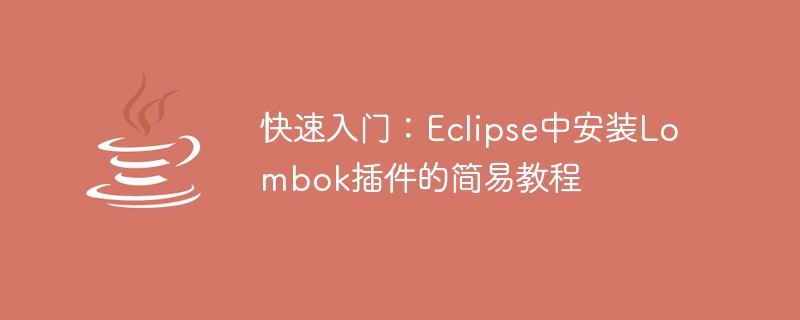Home >Java >javaTutorial >Simple tutorial: Quickly install Lombok plug-in in Eclipse
Simple tutorial: Quickly install Lombok plug-in in Eclipse
- 王林Original
- 2024-01-28 08:06:06851browse

Quick Start: A simple tutorial for installing the Lombok plug-in in Eclipse, specific code examples are required
In the process of developing Java projects, Lombok is often used as a practical plug-in. . Lombok can help us simplify Java code, reduce the writing of boilerplate code, and improve development efficiency. This article will introduce you to how to install and configure the Lombok plug-in in Eclipse, and provide specific code examples.
Step 1: Download the Lombok plug-in
First, we need to download the Lombok plug-in jar package (lombok.jar) from the Lombok official website. Visit https://projectlombok.org and click the "Download" button to download the latest version of lombok.jar.
Step 2: Install the Lombok plug-in
- Open Eclipse and make sure you have installed the JDK.
- In the Eclipse menu bar, select "Help" -> "Eclipse Marketplace".
- In the search box of the "Eclipse Marketplace" dialog box, enter "Lombok" and click the "Go" button.
- In the search results, find the "Lombok" plug-in and click the "Go" button.
- In the pop-up "Lombok" page, click the "Install" button.
- Next, follow the prompts to install the Lombok plug-in through "Eclipse Installer" or "Drag and Drop". If you choose the "Eclipse Installer" method, you need to select your Eclipse installation path and click the "Install/Update" button. If you choose the "Drag and Drop" method, you need to drag and drop the downloaded lombok.jar file into the Eclipse window.
- After completing the installation, restart Eclipse.
Step 3: Configure Lombok plug-in
After the installation is complete, we need to configure Eclipse to use the Lombok plug-in correctly.
- Open Eclipse and select your Java project.
- Right-click the project and select "Properties" in the pop-up menu.
- In the "Properties" dialog box, select "Java Compiler" -> "Annotation Processing".
- Check the "Enable annotation processing" option and ensure that the value of the "Generated source directory" field is the default value "target/generated-sources/annotations".
- Click the "Apply and Close" button to save and close the "Properties" dialog box.
Step 4: Use the Lombok plug-in
After the Lombok plug-in is installed and configured, we can start using it. The following are several commonly used Lombok annotations and examples of their use.
- @Data annotation
@Data annotation can automatically generate JavaBean's getter, setter, equals, hashCode and toString methods.
@Data
public class Person {
private String name;
private int age;
}- @NoArgsConstructor and @AllArgsConstructor annotations
@NoArgsConstructor annotation can automatically generate a parameterless constructor, and @AllArgsConstructor annotation can automatically generate a full-parameter constructor.
@Data
@NoArgsConstructor
@AllArgsConstructor
public class Person {
private String name;
private int age;
}- @Getter and @Setter annotations
@Getter annotation can automatically generate getter methods, and @Setter annotation can automatically generate setter methods.
@Data
public class Person {
@Getter @Setter private String name;
@Getter @Setter private int age;
}- @Builder annotation
@Builder annotation can generate a complex object through the builder pattern.
@Data
@Builder
public class Person {
private String name;
private int age;
}
Person person = Person.builder()
.name("Tom")
.age(20)
.build();Through the above examples, we can see the power of Lombok. It can help us simplify Java code, reduce the writing of boilerplate code, and improve development efficiency.
Summary
This article briefly introduces the steps to install and configure the Lombok plug-in in Eclipse, and provides some common usage examples of Lombok annotations. By using the Lombok plug-in, we can write Java code more easily, reduce duplication of work, and improve development efficiency. I hope this article will help you use the Lombok plug-in!
The above is the detailed content of Simple tutorial: Quickly install Lombok plug-in in Eclipse. For more information, please follow other related articles on the PHP Chinese website!

